stop start MERCEDES-BENZ SPRINTER 2020 MY20 with 7” screen
[x] Cancel search | Manufacturer: MERCEDES-BENZ, Model Year: 2020, Model line: SPRINTER, Model: MERCEDES-BENZ SPRINTER 2020Pages: 348, PDF Size: 5.84 MB
Page 8 of 348
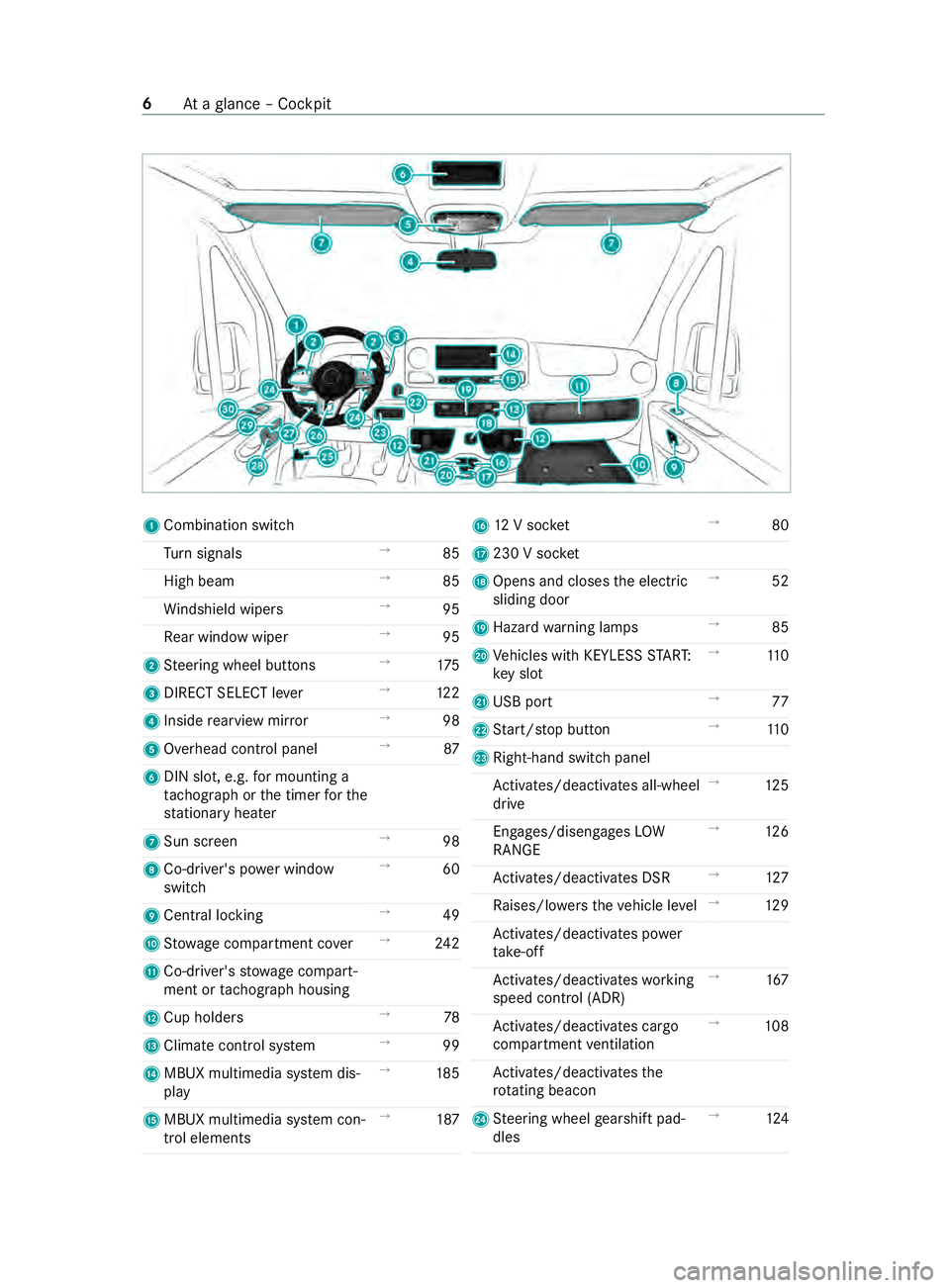
1
Combination swit ch
Tu rn signals →
85
High beam →
85
Wi ndshield wipe rs →
95
Re ar wind owwiper →
95
2 Steering wheel buttons →
175
3 DIRECT SELEC Tlever →
12 2
4 Inside rearvie wmirror →
98
5 Overhea dcontrol panel →
87
6 DIN sl ot,e .g. form ounting a
ta ch ograph or thet imer fort he
st ationar yheater
7 Sun screen →
98
8 Co-d rive r's po werw indow
switch →
60
9 Central locking →
49
A Stow agec ompartment co ver→
24 2
B Co-driver' sstowa ge compart‐
men tort achograph housing
C Cup holders →
78
D Climat econtrol sy stem →
99
E MBUX multimedia sy stem dis‐
play →
185
F MBUX multimedia sy stem con‐
trol elements →
187 G
12Vsocket →
80
H 230 Vsocket
I Opens and closes thee lectric
sliding door →
52
J Hazar dwarning lamps →
85
K Vehicles wit hKEYLESSS TART:
ke ys lot →
11 0
L USB port →
77
M Start/ stop button →
11 0
N Right-hand swit chpanel
Ac tivates/deacti vatesa ll-wheel
drive →
12 5
Engages/disengages LOW
RANGE →
12 6
Ac tivates/deacti vatesD SR →
127
Ra ises/lo wersthev ehicle le vel→
12 9
Ac tivates/deacti vatesp ower
ta ke -off
Ac tivates/deacti vatesw orking
speed control (ADR) →
167
Ac tivates/deacti vatesc argo
compartment ventilation →
108
Ac tivates/deacti vatest he
ro tating beacon
O Steering wheel gearshif tpad‐
dles →
124 6
Atag lanc e–Cockpit
Page 41 of 348
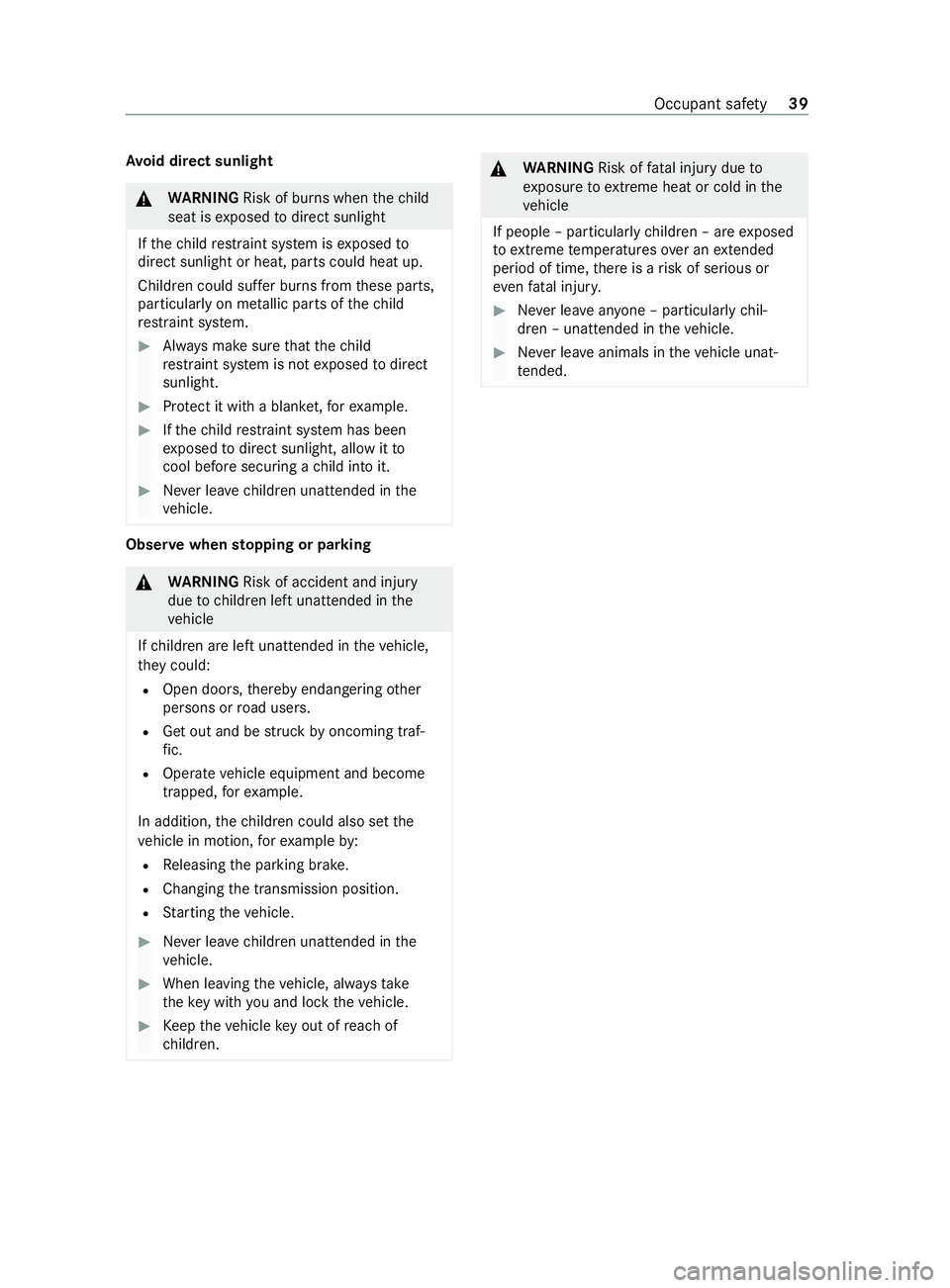
Av
oid direct sunlight &
WARNING Risk of bu rnsw hen thec hild
seat is exposed todirect sunlight
If th ec hild restra int sy stem is exposed to
direct sunlight or heat, parts could heat up.
Children could suf ferb urns from these parts,
particular lyon me tallic parts of thec hild
re stra int sy stem. #
Alwaysm akes uret hat thec hild
re stra int sy stem is no texpose dtodirect
sunlight. #
Protect it wit hablanket,for example. #
Ifth ec hild restra int sy stem has been
ex posed todirect sunlight ,allowitto
cool befor esecu ring achild int oit. #
Neverlea ve children unat tende dint he
ve hicle. Obser
vewhen stopping or parking &
WARNING Risk of accident and inju ry
due tochildren lef tunat tende dint he
ve hicle
If ch ildren ar eleftu nat tende dint hevehicle,
th ey could:
R Ope ndoors,t hereb yendangering other
persons or road users.
R Getout and be stru ck byoncomin gtraf‐
fi c.
R Ope rate ve hicle equipment and become
trapped, fore xamp le.
In addition ,the children could also se tthe
ve hicle in motion, fore xamp leby:
R Releasing thep arking brake.
R Changing thet ransmission position.
R Startin gthe vehicle. #
Neverlea ve children unat tende dint he
ve hicle. #
When leaving thev ehicle, alw ayst ake
th ek eywit hyou and loc kthe vehicle. #
Keep thev ehicle keyo ut of reac hof
ch ildren. &
WARNING Risk offata linjur ydue to
ex posur etoextreme hea torcoldint he
ve hicle
If people –particular lych ildren –areexposed
to extreme temp eratures overane xtended
perio doft ime,ther eisar isk of serious or
eve nfatal injur y. #
Neverlea ve anyone –p articularly chil‐
dren –unat tende dint hevehicle. #
Neverlea ve animals in thev ehicle unat‐
te nded. Occupant sa
fety 39
Page 48 of 348
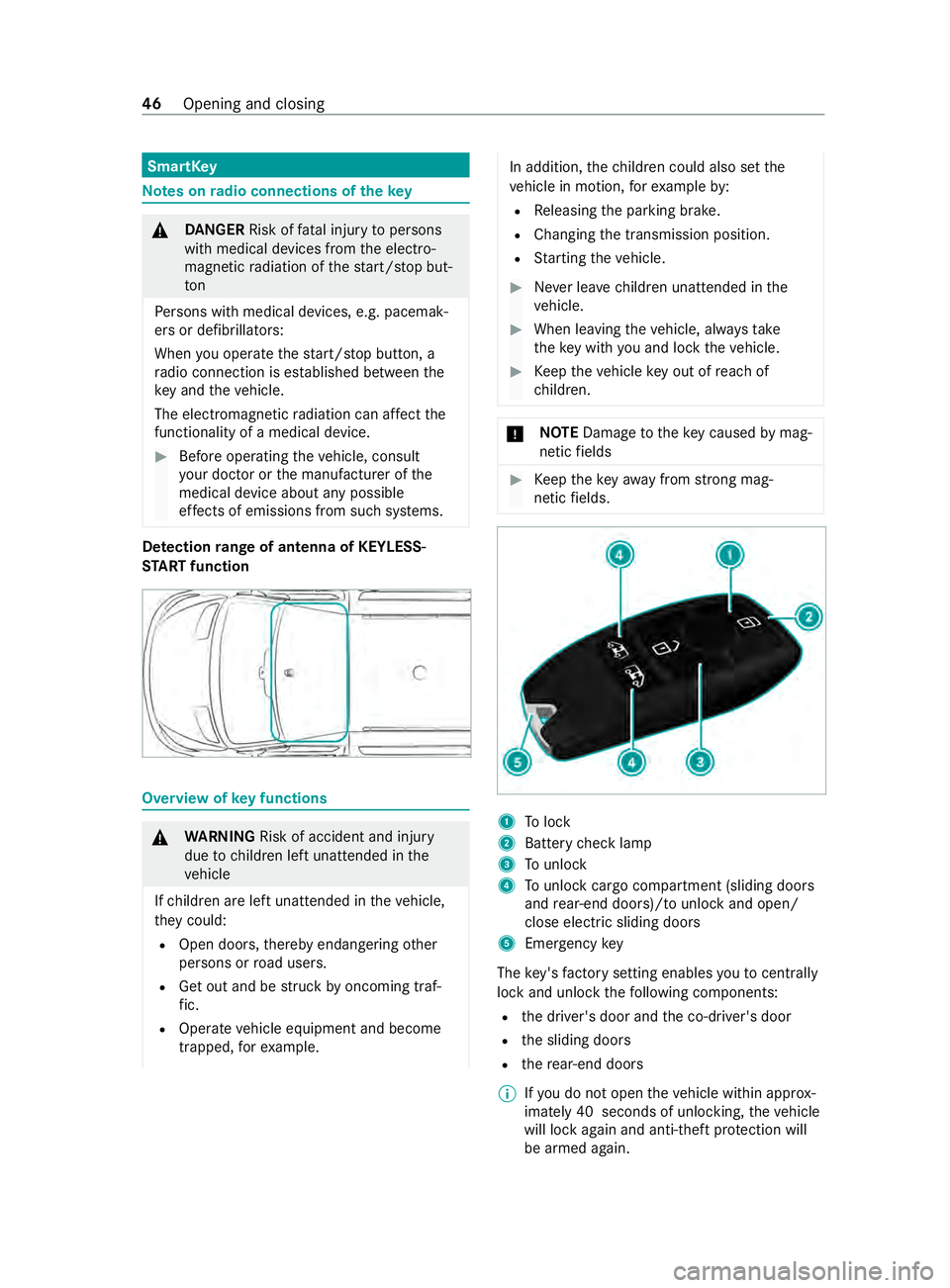
SmartK
ey Note
sonr adio connection softhekey &
DANG ER Risk of fata linjur ytop ersons
wit hm edical devices from thee lectro‐
magnetic radiation of thes tart/s topb ut‐
ton
Pe rsons wit hmedical devices, e.g. pacemak‐
er sord efibrillators:
When youo perat ethe start/ stop button, a
ra dio connection is es tablished between the
ke ya nd thev ehicle.
The electromagnetic radiation can af fect the
functionality of amedical device. #
Befor eoperating thev ehicle, consult
yo ur doc torort he manufacturer of the
medica ldevice abou tany possible
ef fects of emissions from suc hsystems. De
tection rang eofa ntenna of KEYLESS-
ST AR Tfunction Overvie
wofkeyfunctions &
WARNING Risk of accident and inju ry
due tochildren lef tunat tende dint he
ve hicle
If ch ildren ar eleftu nat tende dint hevehicle,
th ey could:
R Ope ndoors,t hereb yendangering other
persons or road users.
R Getout and be stru ck byoncomin gtraf‐
fi c.
R Ope rate ve hicle equipment and become
trapped, fore xamp le. In addition
,the children could also se tthe
ve hicle in motion, fore xamp leby:
R Releasing thep arking brake.
R Changing thet ransmission position.
R Startin gthe vehicle. #
Neverlea ve children unat tende dint he
ve hicle. #
When leaving thev ehicle, alw ayst ake
th ek eywit hyou and loc kthe vehicle. #
Keep thev ehicle keyo ut of reac hof
ch ildren. *
NO
TEDama getothek eycaused bymag‐
netic fields #
Keep thek eyaway from strong mag‐
netic fields. 1
Tolock
2 Battery checkl amp
3 Tounlo ck
4 Tounlo ckcargo compa rtment (sliding doors
and rear-en ddoors)/ tounlo ckand open/
close electric slidin gdoors
5 Emer gency key
The key's factor ysetting enables youtoc entrally
loc ka nd unloc kthe following components:
R thed rive r's door and thec o-driver's door
R thes liding doors
R ther ear-end doors
% If
yo udon otopen thev ehicle within appr ox‐
imatel y40s econds of unlocking, thev ehicle
will loc kagain and anti-thef tprotection will
be armed again. 46
Opening and closing
Page 63 of 348
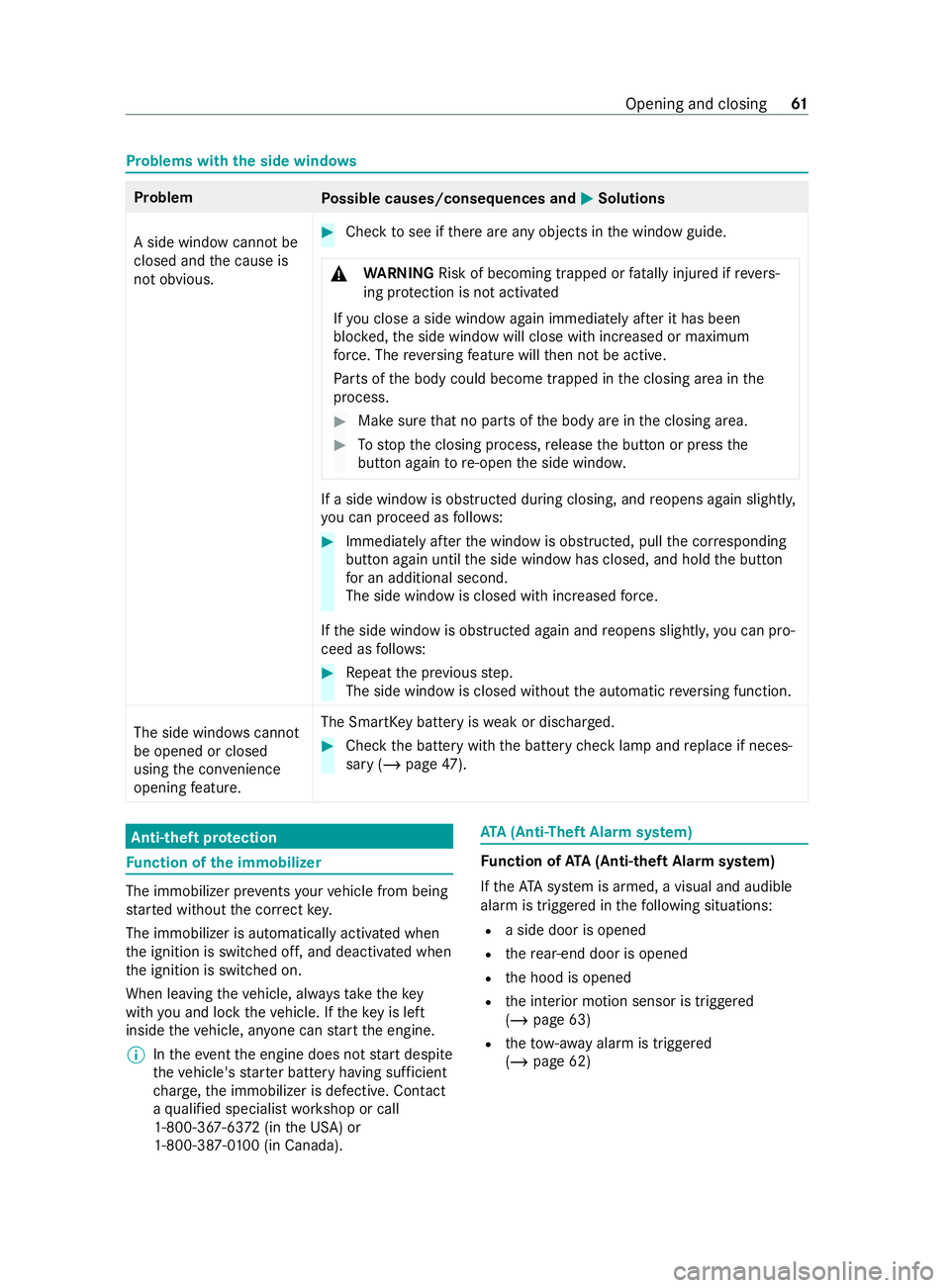
Problems with
thes ide windo ws Problem
Possible causes/consequences and 0050 0050Solutions
As ide windo wcann otbe
closed and thec ause is
no to bvious. #
Chec ktos ee ifther ea reanyo bject sinthe windo wguide.
& WARNING Risk of becoming trapped or fata llyi njured if reve rs‐
ing pr otection is no tactivated
If yo uc lose aside wind owagain immediatel yafter it has been
bloc ked, thes ide windo wwill close wit hincreased or maximum
fo rc e. The reve rsing featur ewillthen no tbea ctive.
Pa rtsoft he body could become trapped in thec losing area in the
process. #
Mak esuret hat no parts of theb ody ar einthe closing area. #
Tostop thec losing process, release theb utton or press the
button again tore-ope nthe side windo w. If
as ide windo wisobstructed during closing, and reopens again slightl y,
yo uc an proceed as follo ws: #
Immedia tely afte rt he windo wisobstructed, pull thec orresponding
button again until thes ide windo whas closed, and hold theb utton
fo rana dditional second.
The side windo wisclosed wit hincrease dforce.
If th es ide windo wisobstructed again and reopens slightl y,yo uc an pro‐
cee dasf ollows: #
Repeat thep reviou sstep.
The side windo wisclosed without thea utomatic reve rsing function.
The side windo wscannot
be opened or closed
using thec onvenience
opening feature. The SmartK
eybatter yisweak or discharged. #
Chec kthe batter ywitht he batter ychec klam pand replace if neces‐
sar y(/pag e47). Anti-thef
tprote ction Fu
nction of thei mmobilizer The immobilize
rpreve nts your vehicle from being
st ar tedw ithout thec orrect key.
The immobilizer is automaticall yactivated when
th ei gnition is switched off, and deactivated when
th ei gnition is switched on.
When leaving thev ehicle, alw ayst aket he key
wit hyou and loc kthe vehicle. If thek eyis left
inside thev ehicle, an yone can star tt he engine.
% In
thee vent thee ngine does no tstart despi te
th ev ehicle's star terb atter yhaving suf ficient
ch arge ,the immobilizer is defective. Contact
aq ualified specialis tworks hop or call
1-800-367-63 72(intheU SA)or
1-800-387-0 100( in Canada). ATA
(Anti-Thef tAlarms ystem) Fu
nction of ATA(Anti- theftA larms ystem)
If th eA TAsystem is armed, avisual and audible
alar mist riggered in thef ollowing situations:
R aside door is opened
R ther ear-end door is opened
R theh ood is opened
R thei nterior motion sensor is triggered
(/ page63)
R thet ow -awa ya larmist riggered
(/ page62) Opening and closing
61
Page 113 of 348
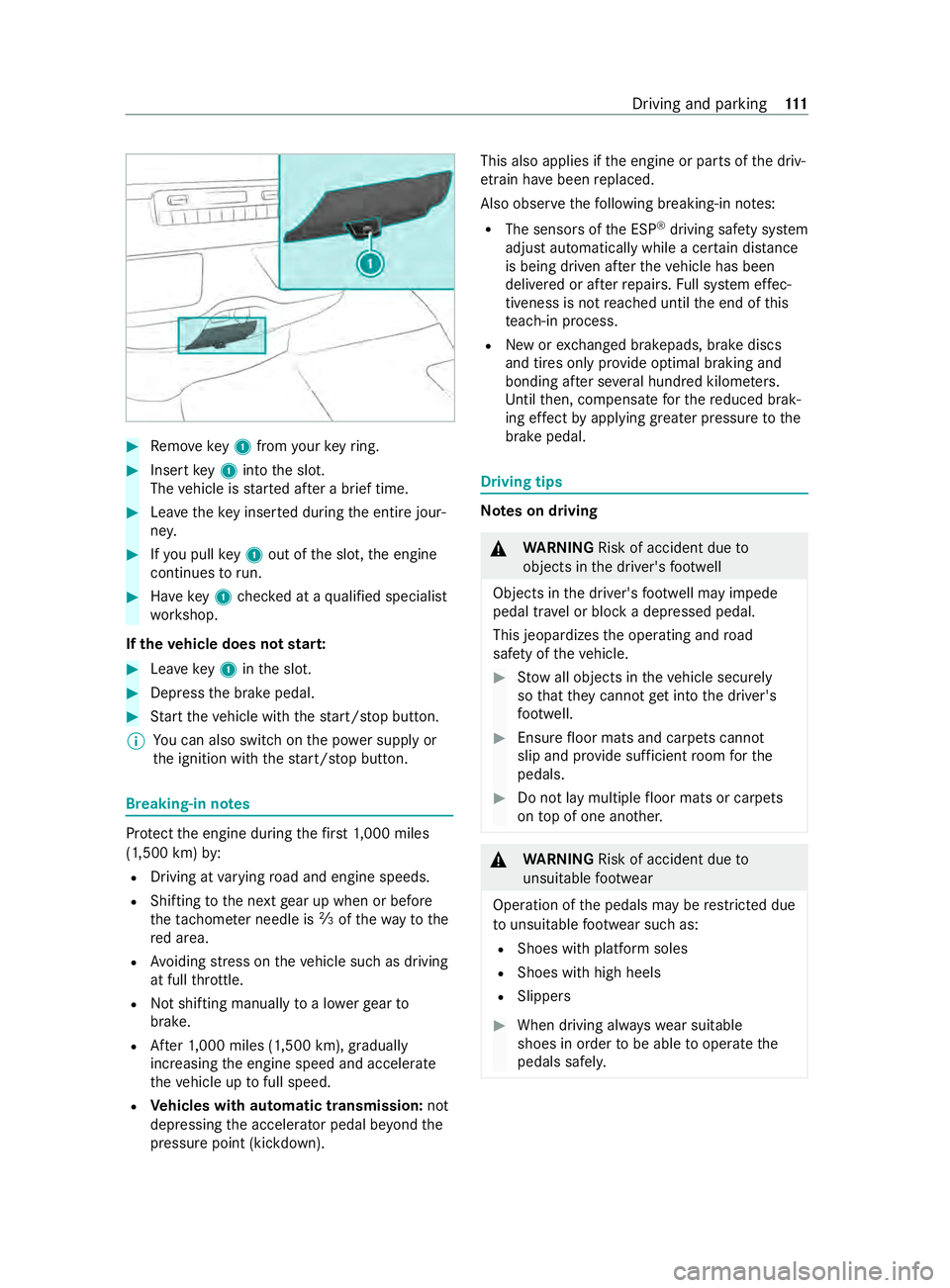
#
Remo vekey 1from your keyr ing. #
Inser tkey 1 intot he slot.
The vehicle is star teda fter ab rief time. #
Leavethek eyinser tedd uring thee ntir ejour‐
ne y. #
Ifyo up ullkey 1out of thes lot, thee ngine
continues torun. #
Have key 1checkedataq ualified specialist
wo rkshop.
If th ev ehicle doe snotstar t: #
Leavekey 1inthes lot. #
Depress theb rake pedal. #
Startt he vehicle wit hthe start/ stop button.
% Yo
uc an also swit chon thep ower suppl yor
th ei gnition wit hthe start/ stop button. Breaking-in no
tes Pr
otect thee ngine during thef irst 1,000 miles
(1,500 km) by:
R Driving at varying road and engine speeds.
R Shifting tothen extg ear up when or before
th et achome tern eedle is 00C3ofthew aytothe
re da rea.
R Avoiding stre ss on thev ehicle suc hasdriving
at full thro ttle.
R Notshifting manuall ytoalowergear to
brake.
R After1 ,000 miles (1,50 0km),gradually
increasing thee ngine speed and accelera te
th ev ehicle up tofull speed.
R Vehicles with automatic transmission: not
depressing thea ccelera torp eda lbeyo ndthe
pressur epoint (kickdown). This also applies if
thee ngine or parts of thed riv‐
et ra in ha vebeen replaced.
Also obser vethef ollowing breaking-in no tes:
R The sensor softhe ESP ®
driving saf etys ystem
adjus tautomaticall ywhile acertain dis tance
is being driven af tert he vehicle has been
delivered or af terr epairs. Full sy stem ef fec‐
tivenes sisnotreached until thee nd of this
te ach-in process.
R Newore xchanged brakepads, brak ediscs
and tires onl yprovide optimal braking and
bonding af ters eve ralh undred kilom eters.
Un tilthen, compensat efor ther educed brak‐
ing ef fect by applying greater pressur etothe
brak epedal. Driving tips
Note
sond riving &
WARNING Risk of accident du eto
object sinthe driver's foot we ll
Object sinthe driver's foot we ll ma yimp ede
pedal tr avel or bloc kadepressed pedal.
This jeopardizes theo perating and road
saf etyoft hevehicle. #
Stow all object sinthevehicle securely
so that they canno tget intot he driver's
fo ot we ll. #
Ensur efloor mats and carpets cannot
slip and pr ovide suf ficient room fort he
pedals. #
Do no tlay multiple floor mats or carpets
on topofo ne ano ther. &
WARNING Risk of accident du eto
unsuitable foot we ar
Operatio nofthe pedals ma yberestricted due
to unsuitable foot we ar suc has:
R Shoes wit hplatform soles
R Shoes wit hhigh heels
R Slippers #
When driving alw aysw ear suitable
shoes in order tobe able tooperat ethe
pedals safel y. Driving and pa
rking 111
Page 131 of 348
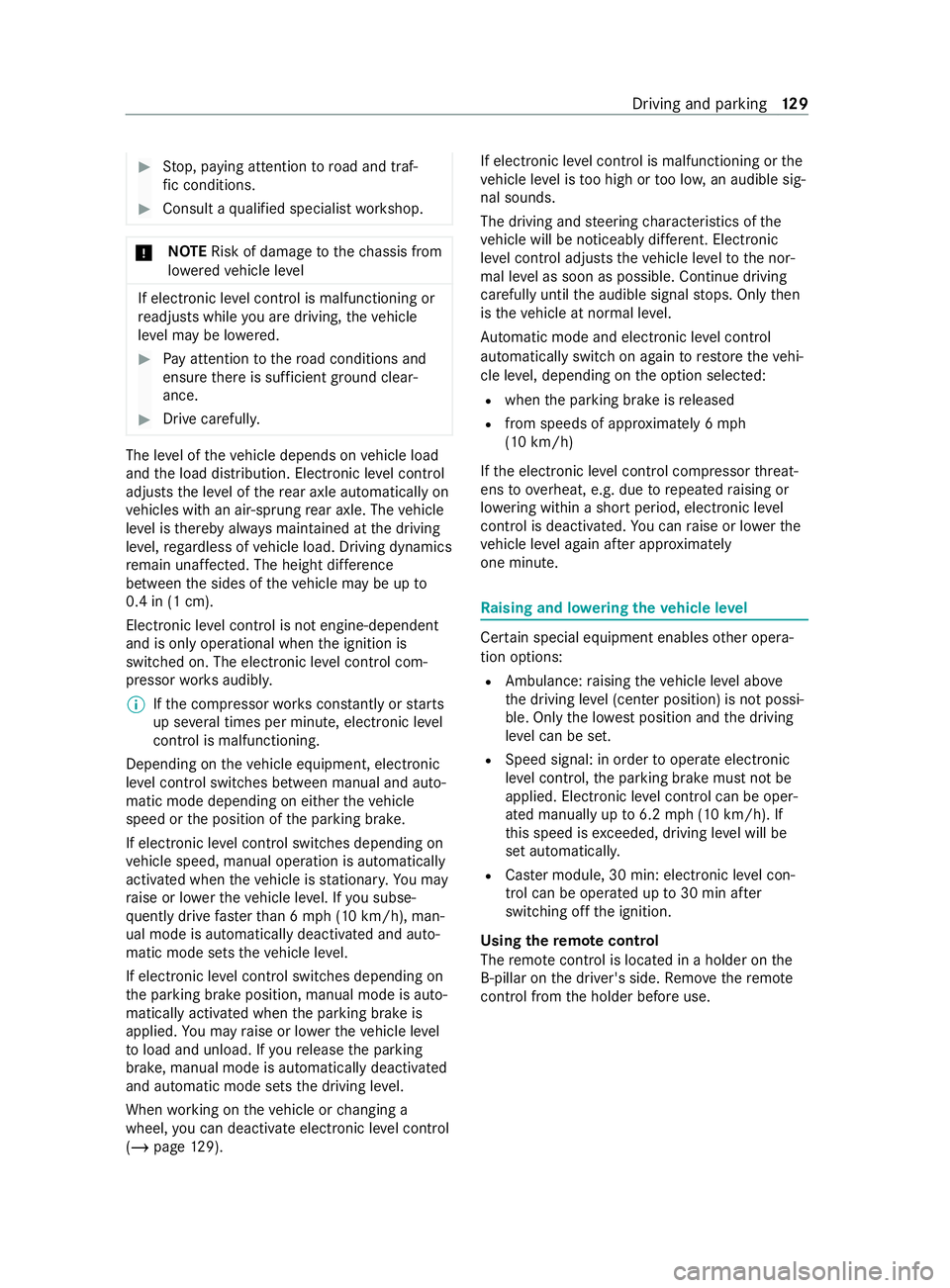
#
Stop, paying attention toroad and traf‐
fi cc onditions. #
Consul taqualified specialis tworks hop. *
NO
TERisk of damag etothechassis from
lo we redv ehicle le vel If electronic le
velc ontrol is malfunctionin gor
re adjusts while youa redriving, thev ehicle
le ve lm aybe lo wered. #
Paya ttention tother oad conditions and
ensur ether eiss ufficient ground clear‐
ance. #
Driv ecarefully. The le
veloft hevehicle depends on vehicle load
and thel oad distribution. Elect ronic le velc ontrol
adjusts thel evel of ther ear axle automaticall yon
ve hicles wit hanair-sprung rear axle .The vehicle
le ve list hereb yalway sm aintained at thed riving
le ve l,re ga rdless of vehicle load. Driving dynamics
re main unaf fected. The height dif fere nce
between thes ides of thev ehicle ma ybeupto
0.4 in (1 cm).
Electronic le velc ontrol is no tengine-dependent
and is onl yoperational when thei gnition is
switched on. The electronic le velc ontrol com‐
pressor worksa udibl y.
% If
th ec ompressor worksc ons tantly or starts
up se veraltimes per minute, elect ronic le vel
control is malfunctioning.
Depending on thev ehicle equipment, electronic
le ve lc ontrol switches between manual and auto‐
matic mode depending on either thev ehicle
speed or thep osition of thep arking brake.
If electronic le velc ontrol switches depending on
ve hicle speed, manual operation is automatically
activated when thev ehicle is stationar y.Yo um ay
ra ise or lo werthe vehicle le vel. If yous ubse‐
qu ently drivefastert han 6mph (1 0km/h), man‐
ual mode is automaticall ydeactivated and auto‐
matic mode sets thev ehicle le vel.
If elect ronic le velc ontrol switches depending on
th ep arking brak eposition ,manual mode is auto‐
maticall yactivated when thep arking brak eis
applied. Youm ayraise or lo werthe vehicle le vel
to load and unload. If your elease thep arking
brake, manual mode is automaticall ydeactivated
and automatic mode sets thed riving le vel.
When working on thev ehicle or changing a
wheel, youc an deactivat eelectronic le velc ontrol
(/ page129). If electronic le
velc ontrol is malfunctionin gorthe
ve hicle le velist oo high or tool ow ,ana udible sig‐
nal sounds.
The drivin gand steering characteristic softhe
ve hicle will be noticeably dif fere nt. Electronic
le ve lc ontrol adjusts thev ehicle le veltot he nor‐
mal le velass oon as possible. Continue driving
carefull yuntil thea udible signal stops. Onl ythen
is thev ehicle at normal le vel.
Au tomatic mode and electronic le velc ontrol
automaticall yswitc hona gain to restor et he vehi‐
cle le vel, depending on theo ption selected:
R when thep arking brak eisreleased
R from speeds of appr oximatel y6mph
(1 0k m/h)
If th ee lectronic le velc ontrol compressor thre at‐
ens to ov erheat, e.g. due torepeated raising or
lo we ring wi thin as hor tperiod, elect ronic le vel
control is deactivated. Youc an raise or lo werthe
ve hicle le vela ga in af tera pproxima tely
one minu te. Ra
ising and lo weringthev ehicle le vel Cer
tain special equipmen tenables other opera‐
tion options:
R Ambulance: raising thev ehicle le vela bo ve
th ed riving le vel(cen terp osition) is no tpossi‐
ble. Only thel owest position and thed riving
le ve lc an be set.
R Speed signal: in order tooperat eelectronic
le ve lc ontrol, thep arking brak emustn otbe
applied. Elect ronic le velc ontrol can be oper‐
ated manuall yupto6.2mp h(10 km/h) .If
th is speed is exceeded, driving le velw ill be
se ta utomaticall y.
R Cas term odule, 30 min: electronic le velc on‐
trol can be opera tedupto30m in after
switching of fthe ignition.
Using ther emo tecontrol
The remo tecontrol is loca tedinah older on the
B‑pilla ronthe driver's side. Remo vether emo te
control from theh older befor euse. Driving and parking
12 9
Page 141 of 348
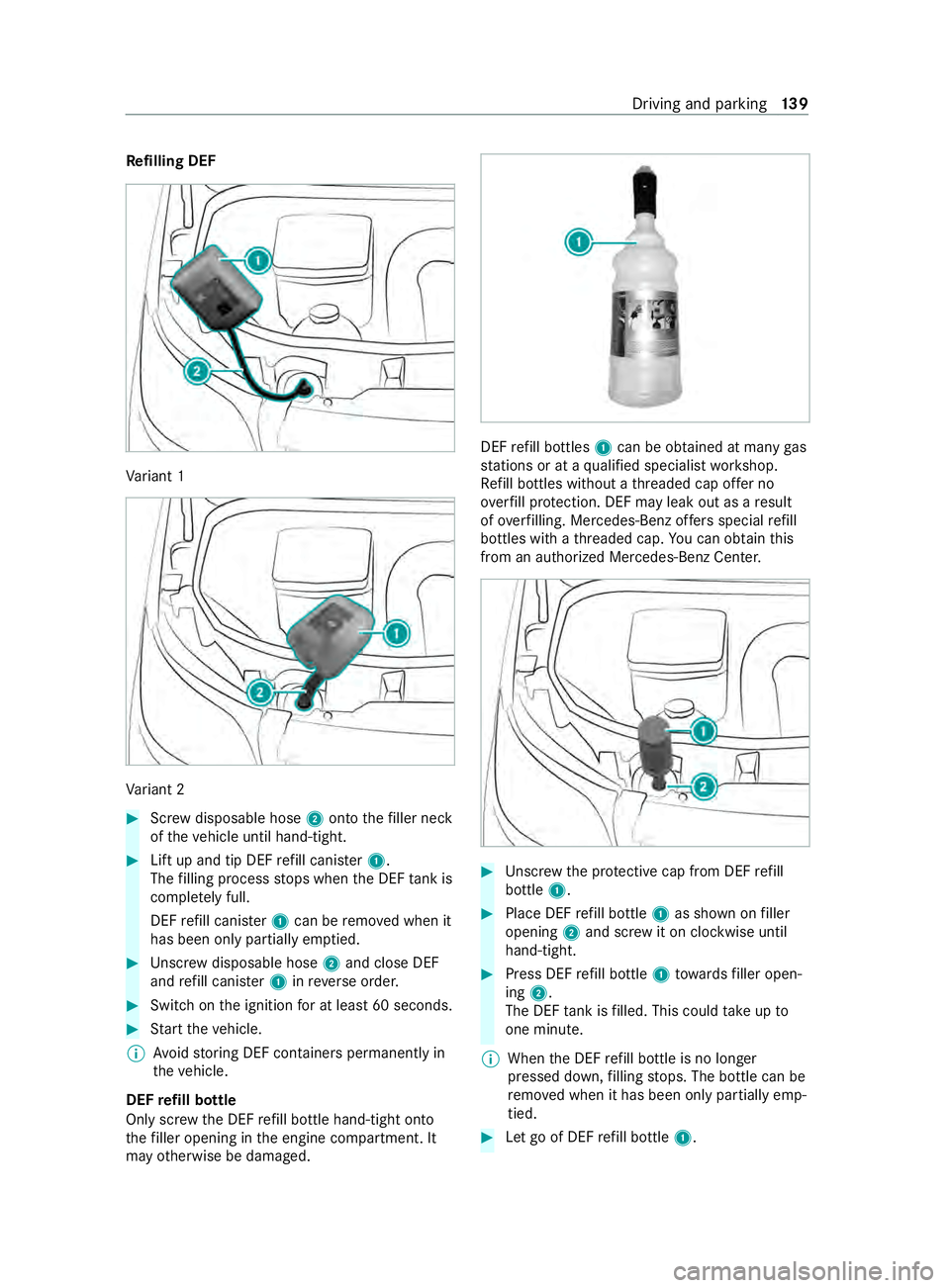
Re
filling DEF Va
riant 1 Va
riant 2 #
Screwd isposable hose 2ontothe filler neck
of thev ehicle until hand-tight. #
Liftupa nd tip DEF refill canis ter1.
The filling proces sstops when theD EFtank is
comple tely full.
DEF refill canis ter1 can be remo vedw hen it
has been onl ypartiall yemp tied. #
Unscr ewdisposable hose 2and close DEF
and refill canis ter1 inreve rseo rder. #
Switc hont he ignition foratl east 60 seconds. #
Startt he vehicle.
% Av
oid storing DEF container spermanent lyin
th ev ehicle.
DEF refill bottle
Onl yscrew theD EF ref ill bottle hand-tigh tonto
th ef iller openin ginthe engine compartment. It
ma yotherwise be damaged. DEF
refill bottles 1can be obtained at man ygas
st ations or at aqualified specialis tworks hop.
Re fill bottles without athreadedc ap offerno
ove rfill pr otection .DEF mayleak out as aresult
of ove rfilling. Mercedes-Benz of fers special refill
bottles wit hathreadedc ap.Youc an obtain this
from an authorized Mercedes-Benz Center. #
Unscr ewthep rotectiv ecap from DEFr efill
bottle 1. #
Place DEFr efill bottle1as shown on filler
opening 2and scr ewit on clockwise until
hand-tight. #
Press DE Frefill bottle 1towa rdsf iller open‐
ing 2.
The DE Ftank is filled. This could takeupto
one minute.
% When
theD EFrefill bottle is no longer
pressed down, filling stops. The bottle can be
re mo vedw hen it has been onl ypartially emp‐
tied. #
LetgoofD EFrefill bottle 1. Driving and parking
13 9
Page 146 of 348
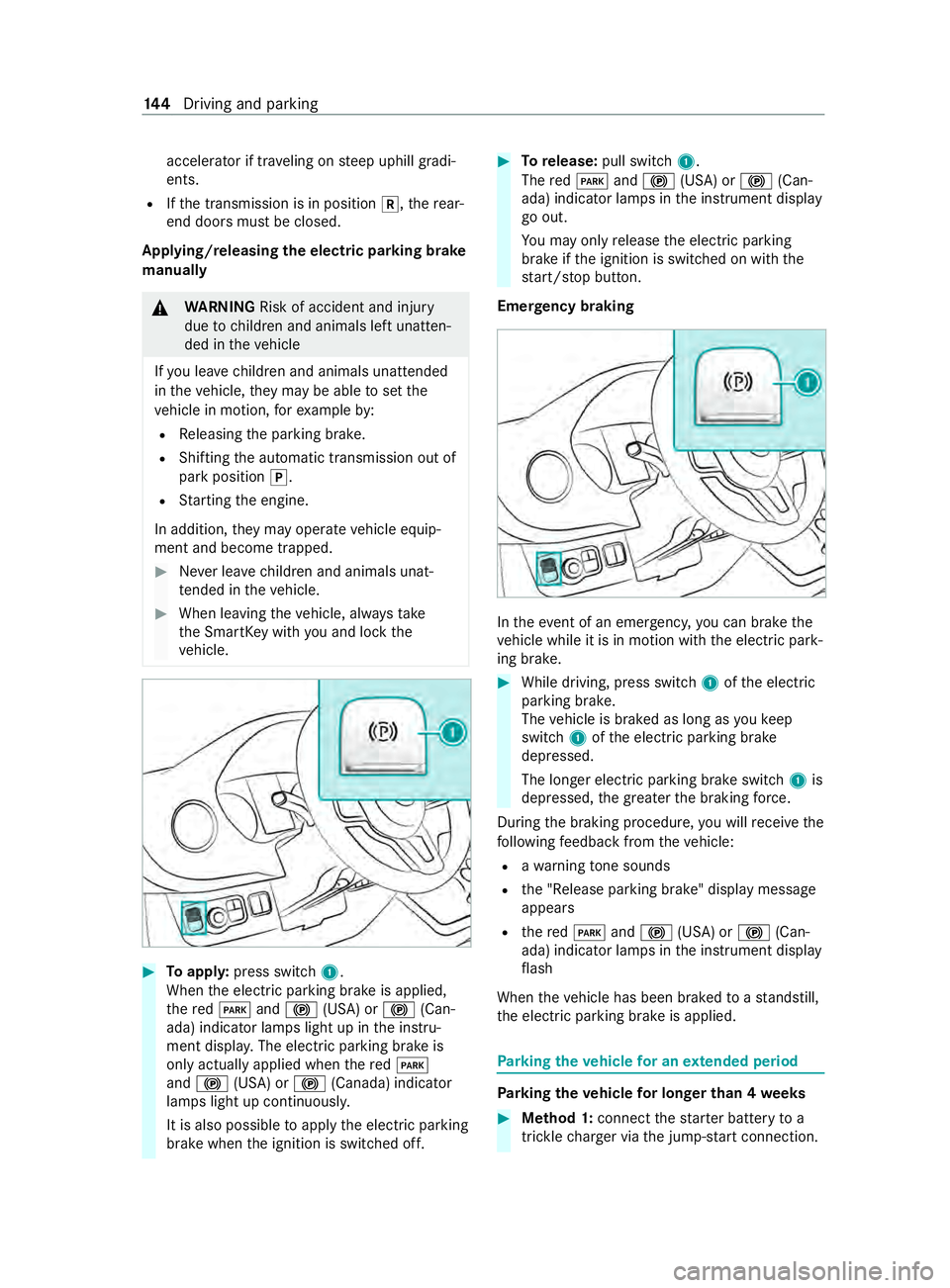
accelerator if tra
veling on steep uphill gradi‐
ents.
R Ifth et ransmission is in position 005E,therear-
end door smustbec losed.
App lying/releasing thee lectric pa rking brake
manually &
WARNING Risk of accident and inju ry
due tochildren and animals lef tunat ten‐
de dint hevehicle
If yo ul eave children and animals unat tended
in thev ehicle, they ma ybea bletos etthe
ve hicle in motion, fore xamp leby:
R Releasing thep arking brake.
R Shifting thea utomatic transmission out of
par kposition 005D.
R Startin gthe engine.
In addition, they ma yoperat evehicle equip‐
ment and become trapped. #
Neverlea ve children and animals unat‐
te nde dint hevehicle. #
When leaving thev ehicle, alw ayst ake
th eS martK eywit hyou and loc kthe
ve hicle. #
Toappl y:press switch 1.
When thee lectric parking brak eisapplied,
th er ed 0049 and0024 (USA) or 0024(Can‐
ada) indicator lamps light up in thei nstru‐
ment displa y.The electric parking brak eis
onl yactuall yapplied when ther ed 0049
and 0024 (USA) or 0024(Canada) indicator
lamps light up continuousl y.
It is also possible toappl ythe electric parking
brak ewhen thei gnition is switched off. #
Torelease: pull switch 1.
The red0049 and0024 (USA) or 0024(Can‐
ada) indicator lamps in thei nstrument display
go out.
Yo um ayonlyrelease thee lectric parking
brak eift he ignition is switched on wit hthe
st art/ stop button.
Emer gency braking In
thee vent of an emergency ,you can brak ethe
ve hicle while it is in motion wit hthe electric park‐
ing brake. #
While driving, press switch 1ofthee lectric
parking brake.
The vehicle is braked as long as youk eep
switch 1ofthee lectric parking brake
depressed.
The longer electric parking brak eswitch 1is
depressed, theg reater theb raking forc e.
During theb raking procedure, youw illreceiv ethe
fo llowing feedbac kfromt hevehicle:
R awarning tone sounds
R the" Release parking brake" displa ymessage
appears
R ther ed 0049 and0024 (USA) or 0024(Can‐
ada) indicator lamps in thei nstrument display
fl ash
When thev ehicle has been braked toas tandstill,
th ee lectric parking brak eisapplied. Pa
rking thev ehicle forane xtended period Pa
rking thev ehicle forl on gerthan 4weeks #
Method 1: connec tthe star terb atter ytoa
trickle charge rv iathej ump-s tart connection. 14 4
Driving and pa rking
Page 158 of 348
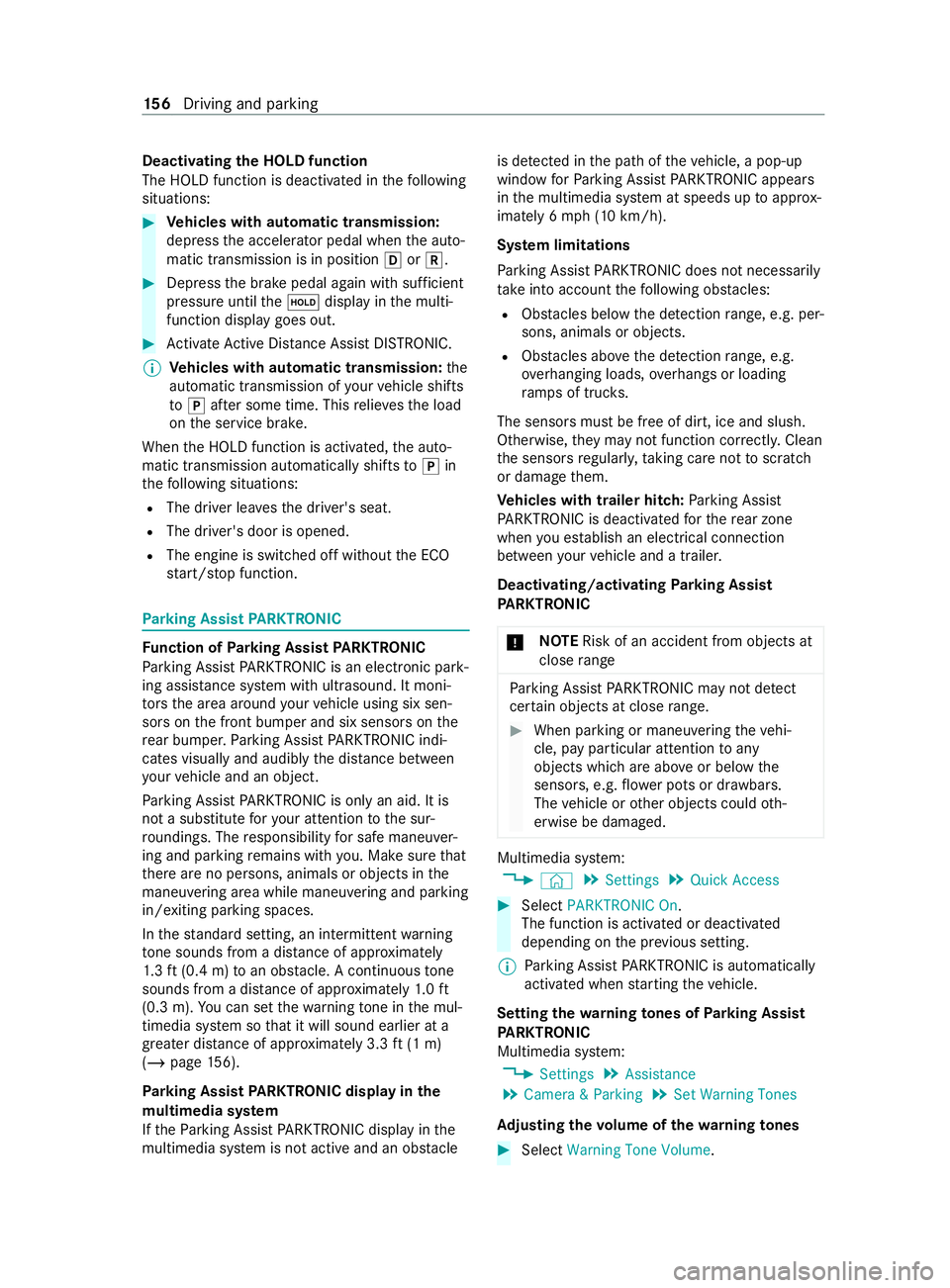
Deactivating th
eHOLD function
The HOLD function is deactivated in thef ollowing
situations: #
Vehicles with automatic transmission:
depress thea ccelerator pedal when thea uto‐
matic transmission is in position 005Bor005E. #
Depress theb rake pedal again wit hsufficient
pressur euntil the 00D9 displa yinthe multi‐
function displa ygoes out. #
Activat eActiv eDista nce Assi stDISTRONIC.
% Ve
hicles with automatic transmission: the
automatic transmissio nofyourvehicle shifts
to 005D afte rs ome time. This relie vest he load
on thes ervice brake.
When theH OLD function is activated, thea uto‐
matic transmission automaticall yshifts to005D in
th ef ollowing situations:
R The driver lea vest he driver's seat.
R The driver's door is opened.
R The engine is switched of fwithout theE CO
st art/ stop function. Pa
rking Assis tPARKTRONIC Fu
nction of Parking Assis tPARKTRONIC
Pa rking Assis tPARKTRONIC is an electroni cpark‐
ing assis tance sy stem wit hultrasound. It moni‐
to rs thea reaa round your vehicle using six sen‐
sor sont he front bumper and six sensor sonthe
re ar bumper .Parking Assis tPARKTRONIC indi‐
ca tesv isuall yand audibl ythe dis tance between
yo ur vehicle and an object.
Pa rking Assis tPARKTRONIC is only an aid. It is
no tas ubstitut efor your attention tothes ur‐
ro undings. The responsibility fors afem aneu ver‐
ing and parking remains wit hyou. Mak esuret hat
th er ea reno persons, animals or object sinthe
maneuvering area while maneuvering and parking
in/exiting parking spaces.
In thes tandar dsetting ,ani ntermit tent wa rning
to ne sounds from adista nc eofa pproximately
1. 3ft( 0.4 m) toan obs tacle. Acontinuou stone
sounds from adista nc eofa pproximately 1.0ft
(0.3 m). Youc an se tthe warning tone in them ul‐
timedia sy stem so that it will soun dearlier at a
grea terd ista nce of appr oximately 3.3 ft(1 m)
(/ page156).
Pa rking Assis tPARKTRONIC displa yinthe
mu ltimedia sy stem
If th eP arking Assis tPARKTRONIC displ ayinthe
multimedia sy stem is no tactiv eand an obs tacle is de
tected in thep athoft hevehicle, apop-up
windo wforParking Assis tPARKTRONIC appears
in them ultimedia sy stem at speeds up toappr ox‐
imatel y6mph (10km/h).
Sy stem limitations
Pa rking Assis tPARKTRONIC does no tnecessarily
ta ke intoa ccount thef ollowing obs tacles:
R Obs tacles bel ow thedetection range, e.g. per‐
sons ,animal soro bjects.
R Obs tacles ab ovethed etection range, e.g.
ove rhanging loads, overhangs or loading
ra mp soft ruck s.
The sensor smustbef reeofd irt, ice and slush.
Otherwise, they ma ynotfunction cor rectl y.Clean
th es ensor sregular ly,t aking ca renottos cratch
or damag ethem.
Ve hicles with traile rhitch: Parking Assist
PA RKTRONI Cisdeactivated fort he rear zone
when youe stablish an electrical connection
between your vehicle and atrailer.
Deactivating/activating Parking Assist
PA RKTRONIC
* NO
TERisk of an accident from objects at
close range Pa
rking Assis tPARKTRONIC ma ynotdetect
cer taino bjects at close range. #
Whe nparkin gorm aneuvering thev ehi‐
cle, pa yparticular attention toany
object swhicha reabo veor belo wthe
sensors, e.g. flowe rpotsord rawbars.
The vehicle or other objects could oth‐
erwise be damaged. Multimedia sy
stem:
4 © 5
Settings 5
Quick Access #
Select PARKTRONIC On .
The function is activated or deactivated
depending on thep reviou ssetting.
% Pa
rking Assis tPARKTRONIC is au tomatical ly
activated when startin gthe vehicle.
Setting thew arnin gtones of Parking Assist
PA RKTRONIC
Multimedia sy stem:
4 Settings 5
Assistance
5 Camera &Parking 5
Set Warning Tones
Ad justin gthe volume of thew arnin gtones #
Select Warnin gTone Volume. 15 6
Driving and pa rking
Page 198 of 348
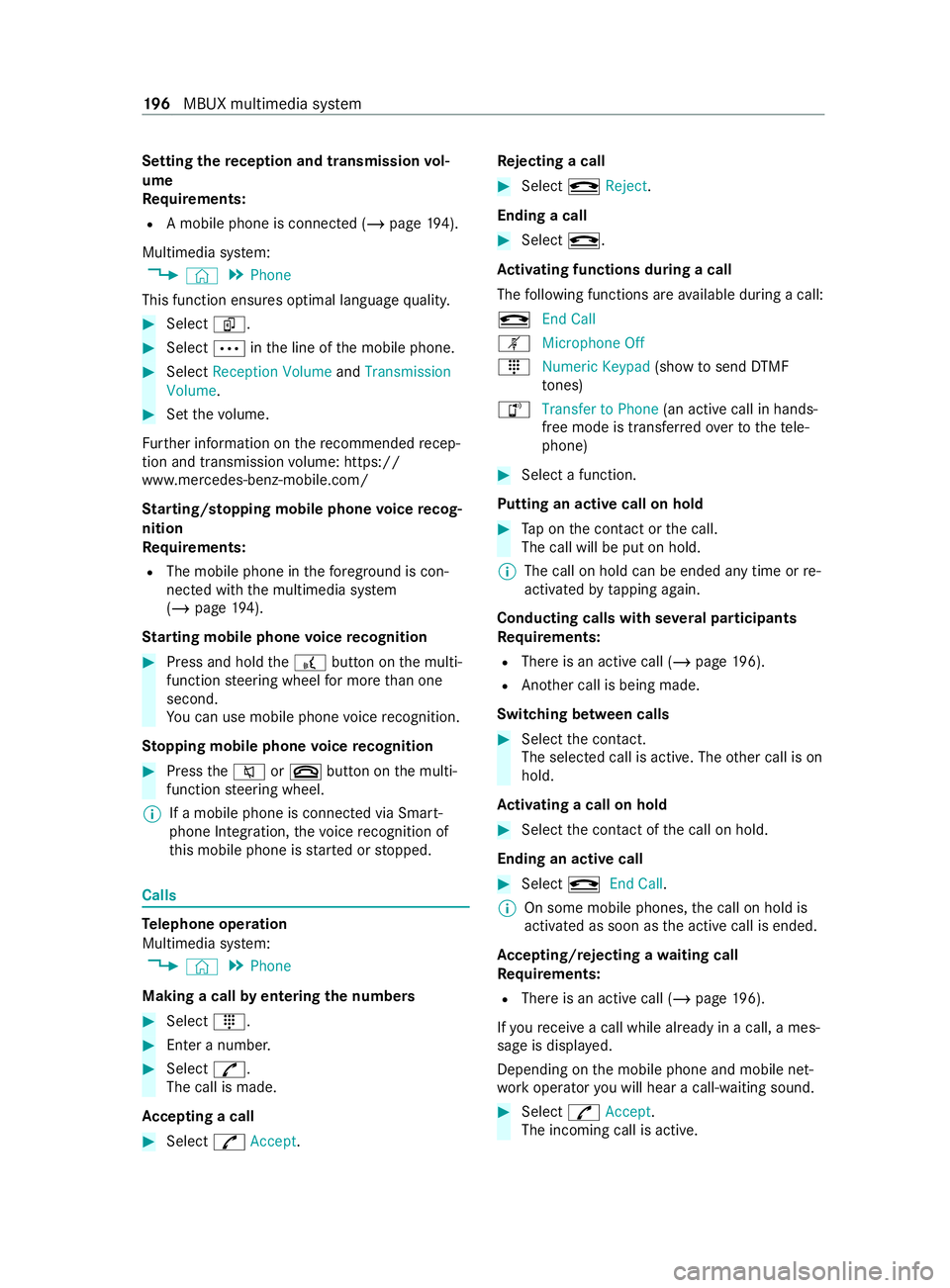
Setting
ther eception and transmission vol‐
ume
Re quirements:
R Am obile phone is connec ted( /pag e194).
Multimedi asystem:
4 © 5
Phone
This function ensures optimal languag equality. #
Select í. #
Select 0062inthel ine of them obile phone. #
Select Reception Volume andTransmission
Volume. #
Setthe volume.
Fu rther information on ther ecommended recep‐
tion and transmission volume: https://
www.me rcedes-benz-mobile.com/
St arting/ stopping mobile phon evoice recog‐
nition
Re quirements:
R The mobile phone in thef oreground is con‐
nected wit hthe multimedia sy stem
(/ page194).
St arting mobil ephone voice recognition #
Press and hold the£ button on them ulti‐
function steering wheel form oret han one
second.
Yo uc an use mobile phon evoice recognition.
St opping mobil ephone voice recognition #
Press the0063 or0076 button on them ulti‐
function steering wheel.
% If
am obile phone is connected via Smart‐
phone Integration, thev oice recognition of
th is mobile phon eisstarted or stopped. Calls
Te
lephone operation
Multimedia sy stem:
4 © 5
Phone
Making acall byentering then umbers #
Select _. #
Enteran umber. #
Select R.
The call is made.
Ac ceptin gacall #
Select RAccept. Re
jectin gacall #
Select kReject.
Endin gacall #
Select k.
Ac tivatin gfunctions durin gacall
The following function sareavailable during acall:
k EndC all
m Microphone Off
_ Numeric Keypad (showtos endDTMF
to nes)
h Transfe rtoPhone (ana ctive cal linh ands-
free mode is transfer redo vertot hetele‐
phone) #
Selec tafunction.
Putting an activ ecall on hold #
Tapont he contact or thec all.
The call will be put on hold.
% The call on hold can be ended an
ytime or re-
activated bytapping again.
Conducting calls wit hseve ralp articipants
Re quirements:
R Ther eisana ctivecall (/ page196).
R Ano ther call is being made.
Switching between calls #
Select thec ontact.
The selected call is active. The other call is on
hold.
Ac tivatin gacallonh old #
Select thec ontact of thec all on hold.
Ending an activ ecall #
Select kEndCall.
% On some mobile phones,
thec all on hold is
activated as soon as thea ctiv ecall is ended.
Ac cepting/rejecting awaiting call
Re quirements:
R Ther eisana ctivecall (/ page196).
If yo ur ecei veac allw hile al ready in acall, am es‐
sag eisd isplayed.
Depending on them obile phone and mobile net‐
wo rkoperator youw ill hear acall-waitin gsound. #
Select RAccept.
The incomin gcall is active. 19 6
MBUX multimedia sy stem